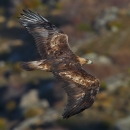U.S. Fish and Wildlife Service (USFWS) Migratory Bird Management Office (MBMO) and USFWS Ecological Services Field Offices (ESFO) in Region 6, have been jointly reviewing Eagle Conservation Plans (ECPs) submitted to USFWS in support of Eagle Incidental Take Permits (EITPs) for eagle take authorization at wind energy facilities that are already operational, or that are being constructed, in Region 6 states (Colorado, Utah, Wyoming, Montana, North Dakota, South Dakota, Nebraska, and Kansas). These applicants are seeking EITPs for their wind energy projects pursuant to the Bald and Golden Eagle Protection Act (BGEPA) and its implementing regulations (CFR Title 50, Part 22). Based on this collective experience we present a new recommended and preferred approach to development of ECPs written and submitted by wind energy companies applying to USFWS, Region 6 for EITPs.
Publication date
Type of document
Protocol
Program
Species
FWS Focus
FWS Focus




